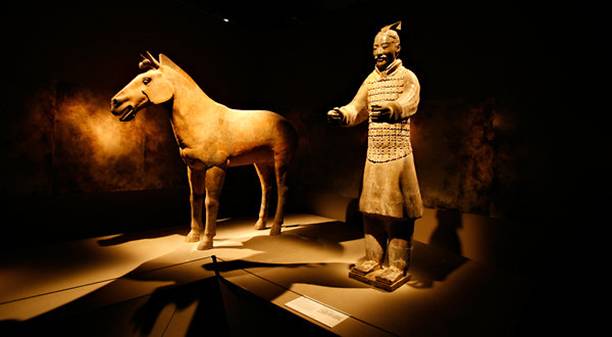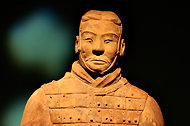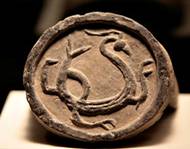更新日期:2012-05-02浏览次数:3675次所属教程:双语阅读
听力原文
导读:‘Terracotta Warriors’ at Discovery Times Square’ 兵马俑现身纽约时代广场
 |
In “Terracotta Warriors,” a life-size charioteer and horse from the third century B.C.
兵马俑—一个真人大小的战车御夫和他的战马(公元前3世纪)
Two millenniums ago, when the last shovelful of dirt fell on China’s terra-cotta soldiers, the thought was that they would be seen in this life no more. Buried in an emperor’s tomb, they would thenceforth secure and patrol imperial turf in the afterlife.
两百年前,当最后一铲泥土落下时,世人皆以为这些中国兵马俑此生都不会被再看到。这些埋葬在皇帝墓穴中的兵马俑会在来世保卫和守护帝王的疆土。
 |
Terracotta Warriors兵马俑
 |
A pre-Qin dynasty roof tile. 一块先秦时代的屋瓦片
Fate had other plans. Since being exhumed in the late 20th century the same soldiers have been on a global Long March, moving from one sold-out museum appearance to the next, and serving as, among other things, emblems of China’s neo-imperial clout in the here and now.
命运总是不尽如人意。自20世纪晚期被掘出以来,同一个兵马俑---作为中国古代君王权威的象征,就已经踏上了全球性的长征,辗转于一个又一个满座的博物馆.
That army, or a small piece of it, has just arrived in New York City in an exhibition called “Terracotta Warriors: Defenders of China’s First Emperor” at Discovery Times Square. Only nine of the estimated 8,000 figures entombed at Xian in central China have made the trip. But they’re in great shape and, fitted out with weapons, armor, livestock, cash and a portable kitchen, they’re a sight to see.
这个已经抵达纽约时代广场并进行展出的军队,或者只是其中之一就是兵马俑:中国第一位皇帝的守卫军。8000多埋葬在中国中部西安的兵马俑中仅有9个参与这次巡展。但是,这些兵马俑身型壮硕并配备有兵器,铠甲,牲畜,钱币和一个袖珍厨房,真是难得一见的奇观。
They also come with an action-adventure narrative, part deep history, part archaeological romance. The history goes back to well before the third century B.C., when north-central China was a chaos of feuding states, all intent on domination. The one called Qin, ruled by horse breeders whose main trade came to lie outside China, seemed least likely to succeed. But when, after centuries of clashes, the dust finally settled, the Qin was left standing, and in command.
这些兵马俑都是富有传奇色彩的故事,一部分源于深厚的历史,一部分源于考古奇迹。追溯历史到公元前3世纪,当时华北大地处于一片混沌的敌对状态,各国都意图控制大局。其中游离于中国大地外部的游牧国家--秦国似乎是最不可能完成这项任务的。然而,几个世纪的征战后,尘埃最终落定,秦国征服各国,使其听命。
Its leaders were almost absurdly ambitious.
秦国君王太过野心勃勃。
Forget about being big fish in a small territorial pond. They wanted to fill and control the biggest pond, China itself, then considered the center of the world, and made quick progress toward this goal.
忘记自己只是小池中的一条大鱼。他们妄图占领并操控最大的池子—中国,被认为是世界中心,并朝着这一目标迅速迈进。
Victories bred further ambitions. Why stop at China? Why not rule the cosmos,?
胜利总会让人滋生更大的野心。为何止步于中国呢?为何不统治整个宇宙呢?
That was the aim of the penultimate and greatest Qin ruler, Ying Zheng, who was born in 259 B.C., assumed the throne at 13 and bestowed on himself a freshly invented title: Qin Shihuangdi, or First Emperor of Qin, which really meant first emperor of China. Power, for him, was the elixir of life. He couldn’t get enough, and seemed neurotically afraid to stop trying.
这就是最伟大的秦国君王—嬴政的目标。秦嬴政生于公元前259年,13岁即位,后自封称号-秦始皇帝,即秦国的第一位皇帝。
Having subdued immense tracts of China’s geography he set about conquering its history too. He gave orders that all chronicles other than those that flatteringly documented the Qin family line be destroyed. Once he had the past under his thumb, he turned a control-freak eye to the future: he would colonize heaven.
已经征服了中国辽阔疆土的秦始皇开始改写历史。他下令焚烧毁灭除讴歌秦王朝历史篇章外的所有史志。他认为只要他将过去玩于鼓掌就能够掌控未来:他就能统治天下。
This he did, or tried to, by creating one of the most ambitious monuments to self on record: a tomb complex more than 40 years in the making — it was still under way when he died at 50 — that reproduced, to scale and in imperishable form, imperial life as he knew it on earth.
他所做的或试图要做的就是通过创造一个最具野心的丰碑来铭刻自己:一个花费40多年时间建造,并在他50岁驾崩之时仍在修建的墓穴,这个按比例建造的不可磨灭的墓穴再现了秦始皇真实的帝王生活。
Empires can’t exist without armies, so he commissioned one made up of thousands of fighters, from five-star generals to humble foot soldiers, modeled from clay, roughly life size, ready to serve. Each figure was dressed by rank, though with uniforms individually customized: an extra sash here, a bulkier coat there. Faces were differentiated too. Although a very limited number of facial molds were used, each face was given hand-modeled features — noses, ears, mouths, moustaches and so on — so that no two looked alike.
为帝王者必有军队,因此秦始皇打造成千上万的秦俑,从五级将军到低等步兵,以粘土成模,大致为真人大小,随时待命。每个秦俑均按级别穿戴量身定制的服制:有的佩戴腰带,有的身着厚重外套。面部特征也各有特点。尽管使用的面部模具数量有限,但每张面孔有各自的面部特征-鼻子,耳朵,嘴巴,胡须等等,因此没有任何2张面孔是相同的。
[page]
The collective result was, and is, remarkable: a fighting machine with multiple personalities. All the figures were finally placed, in battle formation and with teams of terra-cotta horses, in three basement like pits, which were covered over. Other types of clay figures — of civic officials, servants and court acrobats — were buried nearby. And all were under the watchful eye of the emperor, who was interred deep within a mountain of packed earth, his coffin reputedly surrounded by a moat of toxic mercury.
最终的结果是让世人瞩目的:一个各色人物一应俱全的军队方阵。所有秦俑及战马方阵最后都成作战方阵被放置并埋葬进3个俑坑内。其他各种秦俑-文官俑,奴仆及宫人俑都被就近埋葬。所有的一切都永远被埋葬在秦始皇的眼皮下,而秦始皇则被埋葬在很深的位置,其灵柩据说被充盈着毒水银的护城河所环绕。
So that was the history. The Qin empire survived the emperor by fourteen years, to be replaced by the long-lived Han dynasty (206 B.C.-220 A.D.). The tomb greened over. Its contents were forgotten for centuries, which is where the archaeological romance kicks in.
这就是历史。秦王朝统治历时14年时间,后被汉朝取代(公元前206年到公元220年)。秦始皇墓穴上的青草绿了又绿,而埋藏在里面的一切也被遗忘了几个世纪,考古学的魅力所在就是为世人揭开迷雾。
In 1974 farmers who were sinking a well outside Xian hit pottery fragments, which turned out to be the figures of soldiers. Archaeologists were summoned and digging began. It continues today in and around the Terra-Cotta Museum now at the site.
1974年有农民在西安城外凿井偶然发现了陶土碎片,后被证明是残俑片。考古学家齐聚挖掘。直到现在兵马俑博物馆里面和周围还在进行挖掘工作。
Hangar size and a huge tourist draw, the museum is an interesting mix of art display, theater and theme park. The Times Square show — organized with the Shaanxi Provincial Cultural Relics Bureau, the Shaanxi Provincial Museum Association and the China Institute in Manhattan — in certain ways brings it to mind.
大批的游客蜂拥进入西安城,博物馆俨然成了引人关注的艺术展览馆,电影院和主题公园。此次时代广场展览是由陕西省文物局,陕西省博物馆协会和曼哈顿中华学院组织。
First, theater. Visitors, admitted by timed ticket to the Discovery center, are ushered into a smallish room to watch a four-minute docudrama-style film on the First Emperor’s tomb.
首先,持时代广场限时门票的参观者由引领员引领进入一个小房间观看一部有关秦始皇墓穴的纪录片,约4分钟。
When it’s done, the screen lifts to reveal a gallery holding several ponderous bronze ritual objects and an extraordinary suit of Qin tomb armor made from tiny wire-linked limestone plaques.
观看完毕后,屏幕升起,出现一个长廊,里面摆放着一系列青铜祭祀物品和一套尤其特别的秦俑铠甲,这套铠甲由细小金属丝连接石灰石块而制成。
There you move past many more objects, including festive ceramic bowls, stoves, jugs and ceremonial dinnerware, along with some previews of coming attractions. Among them is the earliest example of a terra-cotta warrior yet found in China. Dating from about a century before the First Emperor’s reign, it is clearly a prototype of the army to be, though a homely and diminutive one, the size of a child’s toy.
然后,参观者一一参观很多物品,有节庆用瓷碗,灶炉,水壶以及仪式用餐具,还有接下来要参观物件的预告。其中一件是在中国已经发现的最早的兵马俑。这个可以追溯到秦王朝前一个世纪的兵马俑,尽管模样平凡,身型矮小仅有孩童般大小,但他显然是军队士兵的原型。
We’ve seen some of these sculptures in the city before, notably in the Guggenheim Museum’s 1998 exhibition “China: 5000 Years.” But they lose none of their punch with repeat viewings, and the no-frills display here makes a haunting thing of them.
我们之前已经见到过一些这个城市的雕像,特别是1998年古根海姆博物馆举办的“中国5000年”展览。然而我们并没有留下太过深刻的印象,而这次的展览却给人留下了魂牵梦绕的印象。
Under spotlights, details of craftsmanship and marks of shattering are equally visible. An extra-tall army general seems intent on nailing us with his glance, though what we focus on are the manicured fingernails on his demurely crossed hands.
在聚光灯下,工匠精湛的技艺和岁月流逝的痕迹清晰可见。一个分外高大的军队将军似乎在盯着我们看,而让我们目不转睛的却是他那端端正正交叉的双手上修剪整齐的指甲。
A bare-chested acrobat, face set in stoic concentration, one finger raised high, is, almost tragically, missing a leg. Repair lines cover his body like veins.
一个坦胸露乳的宫人,表情隐忍,一根手指高举,很悲惨地只剩下一条腿。身体上修复过的痕迹像肌肤纹理一般。
With its extremes of light and dark, the show at this point gets a little churchy. But that doesn’t last, thanks to the intervention of a third and last short film, an excerpt from a longer one on regular view at the Xian museum. The clip shows a full-dress re-enactment of a Qin battle scene, with an army of archers shooting at an enemy town. The whizzing arrows on the soundtrack sound genuinely dangerous, like a tornado.
忽而异常明亮忽而又异常阴暗,展览此时有点像在教堂的感觉。但由于第三部和最后一部短片以及一个有关西安博物馆摘要的插入使这个种感觉没有延续太长时间。
The clip is a hoot, pure Hollywood, special effects and all, and a useful reminder of what the emperor’s army is really about.
各种声效是纯好莱坞式的,意在告诉人们帝王军队大体是什么样的。
This impression softens with the appearance of Han material in the last few galleries. Some viewers may find this a letdown. I found it a relief. Militarism is still here, but it’s no longer the whole story. And gigantism is gone, replaced by a modestly proportioned naturalism. You see this in tenderly observed clay images of farm animals, and in the figures of two-foot-high, anatomically correct nude soldiers, looking childlike and vulnerable without their fabric uniforms, now turned to dust.
这种印象随着汉代物品的相继展出而渐渐缓和。一些参观者可能会有所失望。我却感到很宽慰。因为军国主义精神仍在,但已经不再是故事的全部。巨型主义已经不在,取而代之的是较成比例的自然主义。你们可以从这些粘土家畜和看起来孩子气,没有铠甲便脆弱不堪的二尺高的士兵身上看到这些,而所有的一切都已经尘归尘,土归土。
The show’s final piece, a set of low-relief stone panels, from a Han tomb door, mixes all this up. There’s plenty of violence: hunts in heaven, battles on earth. At the same time there are gardens in bloom, lovers in windows and what seem to be amateur theatricals in progress.
这场展览的最后部分是组成汉朝墓穴穴门的石板。这里充满了暴力血腥:天堂中的狩猎,尘世中的战场。同时还有百花盛开的花园,屋檐下的恋人,还有似乎业余的戏剧演出。
At the beginning of the Discovery show we enter a dark tomb and the realm of imperial ego. At the end we exit through another tomb, unassuming, even charming, out into the bustle and lights of the theater district. Art is great. The terra-cotta warriors are awesome. And out is a good way to go.
在展览的开始,我们走进一个阴暗的墓穴和一个帝国的领土。最后我们从另一个不起眼但很吸引人的墓穴走出,回到这个喧闹又明亮的影院。艺术是伟大的。兵马俑是了不起的。而走出来是一个不错的方式。